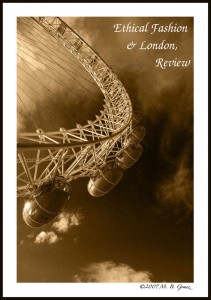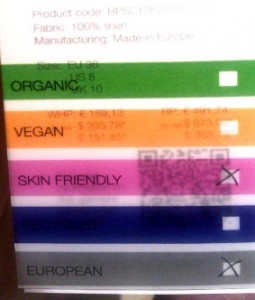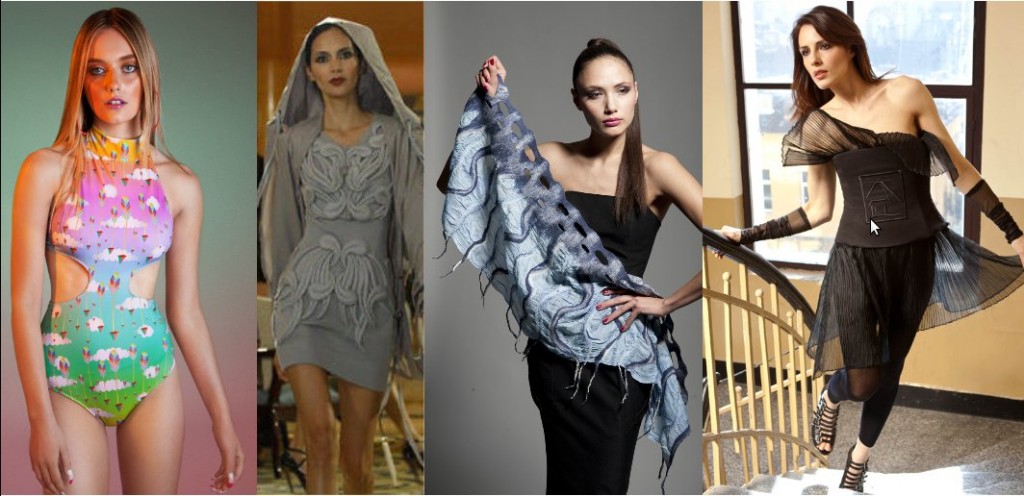 It’s the season again: the fashion pack is back in London on its stop between New York and before Paris and Milan.
It’s the season again: the fashion pack is back in London on its stop between New York and before Paris and Milan.
Thankfully, the September edition of London Fashion Week (LFW) is a wee bit more versatile and larger than the February edition – in short it is more entertaining, and importantly more enlightening than last season. Or probably next.
The lack of a sponsor this year – it used to be Monsoon in the past – was one of the most positive of all aspects. In fact – Monsoon’s public image and target segment did not do the EstEthica designers any good in lifting their reputation. The lack of a sponsor in this case, has done a world of good to the quality of the exhibition.
And even better: where last season’s EstEthica and EcoLuxe were over all fairly disappointing, this season’s edition must be judged as probably the best-as-of-yet. The best EstEthica ever so to speak. Ethical fashion related hence, the news are overall doing well. Whether this is, or not, a side effect of the industry overall (potentially) recovering, or whether it is because ‘the show (and business) must go on, is difficult to say. But the fact is: this season we saw the first ever ‘ethical’ Vogue’s Fashion Night Out (at studio Tammam, to be specific); never has there been an EstEthica as well curated as this time; never has there been so much innovation around and in the air at either EstEthica or EcoLuxe, and some of they old bunch of EstEthica brands has manage to put their foot firmly down on what is the mainstream fashion track – notably without losing their credentials or design signature.
The most interesting part is of course always the first-time brands on show, of which there were (in order of how they appear on the LFW EstEthica website):
- Honest By Bruno Pieters: This is probably the most exciting brand currently on the market. Bruno Pieters challenges the mainstream perception of what you know about fashion. And does it well. Check out the brand’s website and look at the degree of detail of the information available for each garment. Wanna know where your wool jacket grazed? This is the place to shop. Every single step in the garment’s manufacturing process has been accounted for – with names and addresses – in one of the following four categories: Material information, manufacturing details, price calculation, carbon footprint.
And yes – even the price calculations are made public!
Definitely the most forward looking venture in a long, long time. And style wise – it’s all about classy. You buy once, and you’ll be happy to wear it for a few seasons … - Mich Dulce: So few words, so much meaning: Finally a millinery label that combines style with ‘good’ business.
- Auria X Margot Bowman: Swim wear from recycled polyamid – really innovative. But it’s the colours that make it really cool to wear. None of that ‘rich and posh middle aged lady’ stuff. But for all those who actually do swim and do water sports, but want to look dashing without it costing the world. Made in Portsmouth!
- Carla Fernandez Accessories inspired and made by indigenous communities from all over Mexico. With ethnic inspirations, but it is the stuff you really want to wear to feel comfortable in style.
- Lorico The designs of TV princesses it is what Jerome Lorico creates. But beyond that, he’s an expert in working with Pinha (pineapple) fibre. All his designs are made from a cotton/pinha mix, grown in their native habitat, and knitted on hand-knitting machines in one small workshop in Manila. Jerome’s got a real passion for the pinha fibre to gain international recognition, and that what his work is ultimately motivated by.
- Victim Fashion Street This is the ‘odd one out’ among the whole group of EstEthica designers, and carries on the tradition introduced (I think) by Noki: a bit grunge, a bit wild, a bit punk all it one. Different indeed.
- White Tent A young British-Portuguese label that combines classic colour with a young street style flavour.


From EcoLuxe, there is only little news, but 2 mentions.
- Yvian – a sharp tailored brand suitable for business, business casual and the red carpets. And yet where the choice of materials guarantees that you’ll feel comfortable in. Organic wool and or recycled poly-paper, and manufactured in Bulgaria to create jobs where there are none otherwise.
- Arli: Already a regular, the brand keeps surprising with the intrinsic quality of its designs, which combine felted wool with silk in stunning shades of colour. The range of scarves is since recently complemented by accessories such as hats and gloves (which convince less, we think). It is an remains the scarf collection that attracts the eye and the heart.
And a comment: The organisers have evidently leveraged all their connection with the Spanish (ethical) fashion scene. There were a couple of nice surprised in between – but at the same time some of the Spanish exhibitors still need to polish their designs to be absorbed into the mainstream. This is a surprise of sorts, because – to my experience at last – much design that comes out of Spain (and Italy for that matter) are leagues ahead from anything available in the UK.
It’s no doubt great for these Spanish brands to get the London experience, and the exposure to the critical crowed here. I’m now rather curious to see how they’ll develop their offering.
Conclusion:
2 main things could be observed when scratching the surface of what the designs offer beyond mere visuals.
- Atypical materials start to finally creep into the designers consciousness. Pinha as a fashion material is nearly unheard of, as are recycled polymid and poly-paper are but examples. This is good news, because much of what the sustainability discussion in fashion will be about is alternative materials to cotton and polyester.
- Ethical fashion is growing up. There is less grunge and rock’n’roll, and more street and business style, right down to sharp cuts suitable for board meetings in a high-salaried environment. This is good news.
- New types of garments start to get ‘ethical’ coverage: ladies’ hats, swimwear, underwear are just the top of the iceberg.
- Transparency and traceability is venturing into the limelight. And with this, the fact that consumers will – hopefully rather sooner than later – be able to make well informed decision about what they buy.
- Sustainable fashion need by no means to be expensive. Yvian sells at around £150 (trousers) to £250 (girl’s tuxedo); Arli at round £80. That Junky Styling is affordable, in principle, is old news. Of course it is not Primemark. But it is far from what I would consider ‘expensive’, and very much in the range of what a good garment costs at high street retailers such as John Lewis.

